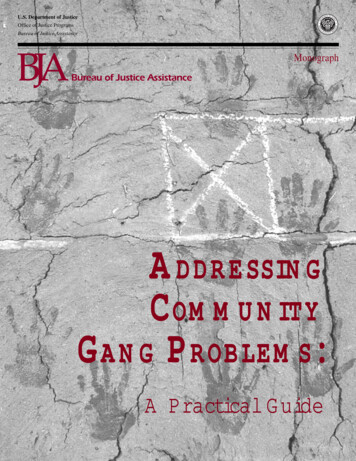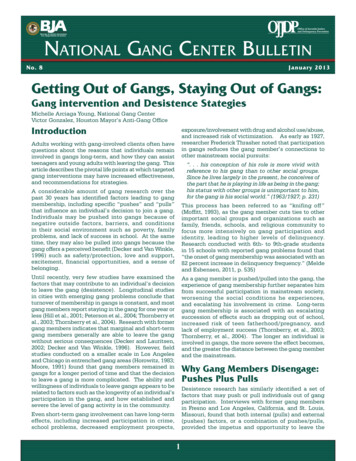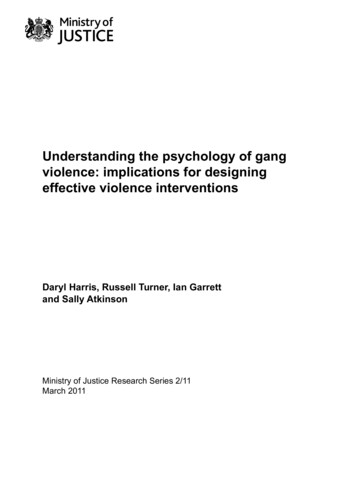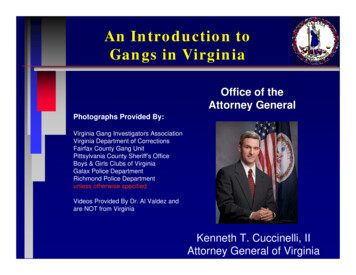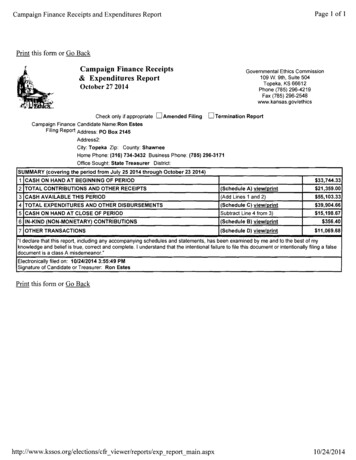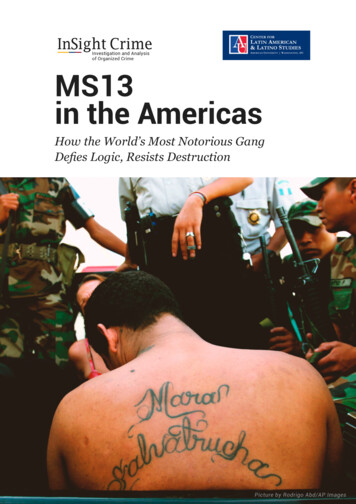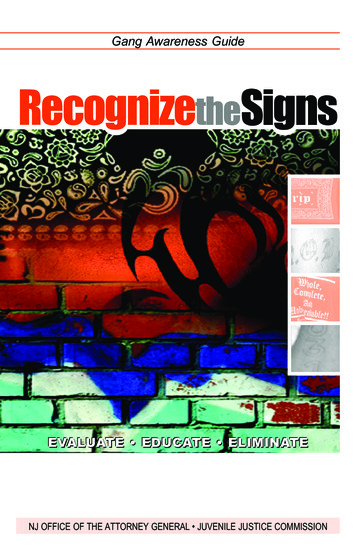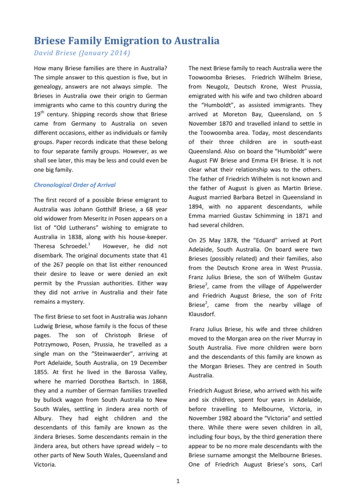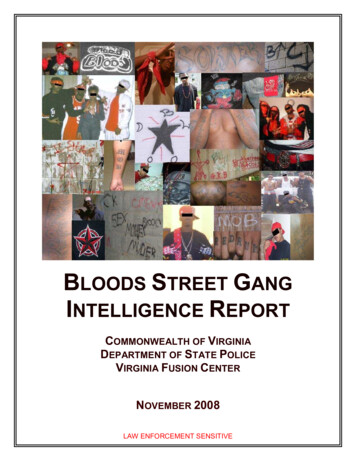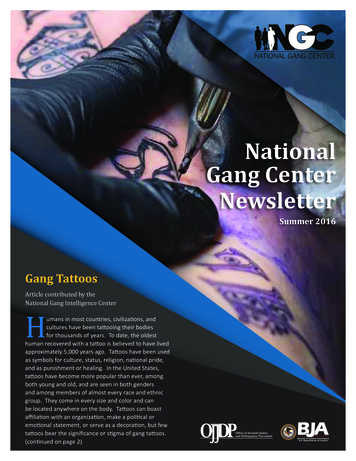
Transcription
NATIONAL GANG CENTERNationalGang CenterNewsletterSummer 2016Gang TattoosArticle contributed by theNational Gang Intelligence CenterHumans in most countries, civilizations, andcultures have been tattooing their bodiesfor thousands of years. To date, the oldesthuman recovered with a tattoo is believed to have livedapproximately 5,000 years ago. Tattoos have been usedas symbols for culture, status, religion, national pride,and as punishment or healing. In the United States,tattoos have become more popular than ever, amongboth young and old, and are seen in both gendersand among members of almost every race and ethnicgroup. They come in every size and color and canbe located anywhere on the body. Tattoos can boastaffiliation with an organization, make a political oremotional statement, or serve as a decoration, but fewtattoos bear the significance or stigma of gang tattoos.(continued on page 2)Bureau of Justice AssistanceU.S. Department of Justice
Gang Tattoos (continued)Gang tattoos are identifiers to show that individuals are part of a gang,which many consider to be their extended family. Gang tattoos aresymbols of a strong group identity and allow wearers to boast thatthey are proud of their gang and their turf and that they have a strongcommitment to both, giving gang members a sense of identity and selfworth. A tattoo also advertises that the wearer is a member of a specificgang. If that gang is known for violence, the member wearing the tattoowill most likely be considered dangerous by association, making him orher feel invincible and protected. Tattoos are also used to identify fellowgang members and rivals.Acronyms are often used to identify gangs. Some examples are MS-13for Mara Salvatrucha, GD for Gangster Disciples, VL for Vice Lords, EMEfor the Mexican Mafia, and UBN for the United Blood Nation.Numbers are important indicators in a tattoo. They can representTable of ContentsGang TattoosPages 1–5Partnerships for Success:A Synergy Between Businessesand Youth Job-Training ProgramsPages 6–9Webinar—Street Outreach andLaw Enforcement Collaboration:Prioritizing Safety When WorkingWith Gang Membersstreet numbers, block numbers, or area codes of the geographic areawhere the gang has a presence, such as the 312 area code for downtownChicago worn by the Vice Lords. A number can also represent a letter inthe alphabet to signify the gang name, such as 13 used by Hispanic gangsto show allegiance to the Mexican Mafia, since M is the 13th letter in thealphabet.Symbols or pictures also can be gang indicators in a tattoo, such asthe Black Hand of the Mexican Mafia, the heart with wings of the BlackGangster Disciples, or the top hat and cane of the Vice Lords.Placement of the tattoo on the body holds a special significance forsome gangs. Tattoos can be located on the face, scalp, neck, chest,hands, fingers, legs, or back.Page 10A Plan for Program SustainabilityPage 11What’s New?Page 122 / National Gang Center Summer 2016 Newsletter
BloodsThe most common identifiers for the Bloods include the 5-pointed star tattoo, which shows the gang’sallegiance to the People Nation; MOB, which stands for either Member of Blood or Money over Bitches;and a dog paw mark made of three burn marks. The positions of the paw marks can designate differentBlood sets.CripsAlmighty Latin King Nation (ALKN)Identifiers for the Latin Kings include the lion, which is the king of the jungle, and the 5-pointed crown,which represents love, honor, obedience, sacrifice, and righteousness. Also common are the letters ADR,which stand for Amor de Rey—the love of the King, or the King’s love.3 / National Gang Center Summer 2016 NewsletterEXAMPLESAmong the Crips’ identified symbols are the Crips name, the 6-pointed Star of David, and the number6, which show allegiance to the Folk Nation. The six points of the star stand for life, loyalty, knowledge,wisdom, understanding, and love. They also use the letter C, for Crips.
Gang Tattoos (continued)SureñosEXAMPLESThe most common identifier for the Sureños is the number 13, whichrepresents the letter M in the alphabet and signifies the gang’s allegiance tothe Mexican Mafia. Also common is the word SUR, which means “southern”in Spanish. The two bars with three dots represent Mayan numerology: 1bar 5, 1 dot 1, for a total of 13.Mara Salvatrucha (MS-13)Symbols and tattoos for MS-13 are the letter M or EME ESE,which is the Spanish pronunciation for the letters MS, andthe devil’s pitchfork, also known as La Garra (Spanish for “theclaw”), which, when pointed down, is the letter M.4 / National Gang Center Summer 2016 Newsletter
Though tattoos can be a sign of gang membership, they must be evaluatedalong with other indicators in order to make a definite designation, sincesome tattoos are used by both gang members and the general population.The spiderweb, for instance, is used by street and prison gangs, but it isalso popular with nongang members as a decorative tattoo. When thespiderweb is worn by gang members, it indicates that the individual hasserved or is currently serving time in prison and is “caught in the web” ofthe justice system. It can also mean that a gang member is caught in theweb of the gang lifestyle. Some white supremacist gangs use the spiderwebto support racism.Three dots—which can be found anywhere on the body, but often on thehand or near the eye—are used by many different gangs as well as nongangmembers. It means mi vida loca, or “my crazy life.” It can representChristianity’s holy trinity, or three places gang life will lead: hospital,cemetery, or prison.The theater-masks tattoo with “Smile Now, Cry Later” or “Laugh Now, CryLater” is associated with both gang and nongang members. It symbolizesthe philosophy to do what you need to do and enjoy life now, becausetomorrow you may be dead or in prison. It can also mean stay strong nowand deal with whatever life brings later.Though tattoos have played a major role in gang culture, many gangmembers are now steering away from large, conspicuous tattoos, since theyserve to flag law enforcement. Instead, gang members are either avoidingtattoos altogether; placing them inconspicuously on the body, such as insidethe lip; trying to disguise them, such as the lipstick mark used by Sureños,which is symbolism for their 13; or hiding them within larger tattoos.Gang Tattoo RemovalPicture courtesy of Homeboy IndustriesThe negative stigma associated with gang tattoos is often a majorobstacle for employers who would otherwise be willing to hire formergang members. Although there has been a general proliferation oftattoo-removal services, locating gang-tattoo-removal programs is acontinuing challenge for many communities. Jail to Jobs, a Section 501(c) 3 public charity, is an organization that gives previously incarceratedmen and women the tools they need to find employment. Jail to Jobshas amassed a directory of clinics and services across the United Statesthat include gang-tattoo-removal programs. Currently, more than200 free and low-cost tattoo removal programs in 37 states have beenentered into the directory. For more information, al/#.5 / National Gang Center Summer 2016 NewsletterEXAMPLESOther Key Tattoos
Partnershipsfor Success: ASynergy BetweenBusinessand YouthJob-TrainingProgramsMaRhonda Y. EcholsYouth and Gang Violence Prevention CoordinatorOffice of City Manager—Newport News, VAAcross the nation, gang activityimpacts the overall health ofour communities. From largemetropolitan cities, to small townsand even rural communities, youthgang violence takes a significant toll.Aside from the individual effects feltby these youth and their families,societal costs are placed on both thepublic and the private sector.For the public sector, gang activity translates into enormousexpenditures related to crime suppression, incarceration, andmedical treatment and care. For businesses, gang violence(or even the mere perception of it) can impact the way inwhich they operate. Not only can these businesses becometargets for theft and crime, but they also can incur physicalcosts related to repairs and property maintenance as well asrevenue losses, since patrons tend to avoid high-crime areas.Impacted businesses can face higher taxes and insurancepremiums as well as a decline in property values.Clearly, there are enough justifications for the publicas well as the private sector to invest in preventing andcurbing gang activity. Moreover, in the case of businesses,engaging in community work has become an imperative asthey seek to become more responsible and accountable.The concept of corporate social responsibility continuesto be integrated into business practices, recognizing thatbusinesses are key stakeholders that have both the capacityand the responsibility to contribute to social and economicdevelopment.6 / National Gang Center Summer 2016 Newsletter
One way for businesses to work toward building stronger communities in gang-impacted areas isto provide employment experiences for youth who are at risk for gang involvement or for thosewho are members of a gang. Productive opportunities and access to work are among the bestways in which youth can realize their aspirations, utilize their potential, positively participate insociety, and lead productive lives.Training and Then What?A recommended strategy in youth gang prevention and interventioninitiatives is to help these youth gain practical and marketable skills througha comprehensive job-training program. These programs are commonlyconnected with intensive support services such as one-on-one mentoring,mental health counseling, anger management, substance abuse treatment,and other services that build job readiness skills. The ultimate goal of allthese interventions is for youth to be adequately prepared for entry-levelemployment or internships in today’s job market.However, the path to finding jobs for youth who had or are at risk of having any ties with gangactivity is far from simple. Typically, for most youth, summer jobs or internships are their firstformal workplace experiences, giving them valuable opportunities to apply newly learned skills,practice workplace behavior, and develop positive professional relationships. Conversely, forgang-involved youth, there are serious barriers to accessing these types of opportunities, sincemany businesses are apprehensive about hiring gang-involved youth or those at risk, leaving thispopulation stigmatized and devoid of productive options.How to Engage the Business CommunityJob-training programs that seek to truly understand employers’ needs are better positioned toprovide relevant training and offer real solutions to businesses. Employers want to be assuredthat the youth presented to them for employment are qualified and part of a comprehensivetraining program. Employers are often motivated when they see a job-training program as a wayto reduce recruitment and internal training costs, since they are able to access a pool of job-readycandidates.Effective job-training programs serving gang youth must embrace creative job placement solutionssuch as subsidizing employers who are willing to accept them as interns or employees (e.g., payingfor their first month of employment for job-ready youth). Preparing youth to be job-ready means7 / National Gang Center Summer 2016 Newsletter
Partnership forSuccess(continued)that they understand what to expect in the workplace and what employers expect of them. Tothis end, one-on-one mentoring by an individual outreach worker guides and supports youthto problem-solve, respond to supervisors’ directions and feedback, and establish an overallgood work ethic.In order to ensure a successful experience, employers who participate in these types ofprograms should receive guidance and support from job-training specialists and outreach staffon how to structure job placement. Establishing formal agreements about expectations andresponsibilities is key. This planning process allows businesses to prepare work assignmentsand resources in advance and assign appropriate supervision for new workers.In the long run, when businesses invest in youth, particularly at the local level, they strengthentheir public image, which, in turn, leads to greater trust by consumers and enhances investorappeal. At the same time, these target youth and their families and networks are alsoimportant stakeholders, and they should be considered as potential customers.An Innovative Job Training StrategyAn exemplary job-training program is Virginia’s Newport News Youth and Gang ViolenceInitiative’s Summer Training and Enrichment Program (STEP). STEP is a ten-week programthat serves young people between the ages of 16 and 24. The program is designed to prepareyouth for their futures by exposing them to various employment and career options. Youngpeople learn valuable skills such as résumé preparation, job interview techniques, timemanagement, financial management, professional work behavior, and networking. In additionto training, participants are given the opportunity to engage in field trips to various businessesand organizations to gain direct exposure to the business community.Following an employment prescreening process, these youth are matched with employers,and all will receive support and follow-up every step of the way. Youth outreach workers andjob-training staff members monitor the youths’ progress at their work sites and engage inongoing communications with employers to ensure a positive experience for both youth andemployers.8 / National Gang Center Summer 2016 Newsletter
The tremendous value of the partnership between job-training programs and businesscommunities cannot be underestimated. Testimonials from participants and mentors reveal theimpact of these job placements. For example, according to the Newport News STEP job coach,one youth who was living in a condemned house with her mother when she started STEP wenton to secure a stable housing situation. She credits her job in helping her achieve this. Similarly,another participant went from believing that the world was against her and that no one was onher side to working well at her site and having faith in society.Another success story is of two program participants known for alwaysassociating with the wrong crowd. Late one night, as their group waspreparing to leave, the two STEP participants stated, “We’re not goingout tonight—we have to get up early for work tomorrow.” STEP and therelationship with the employer had imparted a sense of responsibilityand led them to make better decisions. Participants themselves reportedthat the program had kept them off the streets, provided an opportunityto gain good work experience, assisted them financially, and offered theman opportunity to make a difference.STEP has been so successful that Canon, Virginia, Inc., a major corporation, is now one of STEP’sbiggest supporters. Last year was Canon’s first time partnering with STEP, and the company didnot exactly know what to expect. Canon was so impressed with the job performance of oneyoung male placed with them that he was given the opportunity to participate in an interviewprocess; he is now a full-time employee. Canon is an excellent partner, not only because of itswillingness and commitment to provide work opportunities to young people, but also because ofits ability to train potential employees. As a result of this positive experience, Canon has signedup to partner with STEP again this year. By providing a short-term work experience to high-riskyouth, employers such as Canon are given the opportunity to see whether a given candidate hasthe potential to fill workforce needs before hiring him or her, creating a win-win strategy in whichboth the youth and the employer benefit.Programs such as STEP show that there is a role for communities and business to refocus theircommitments to provide an opportunity for disenfranchised youth. Ultimately, gaining workexperience is a vital part of these youths’ journeys to integrate and lead productive lives.For more information about the STEP program, -Prevention.9 / National Gang Center Summer 2016 Newsletter
Street Outreach and LawEnforcement Collaboration:Prioritizing Safety When WorkingWith Gang MembersOn March 16, 2016, the NGC participated in a collaborativeWebinar titled “Street Outreach and Law EnforcementCollaboration: Prioritizing Safety When Working WithGang Members,” with the Office of Juvenile Justice andDelinquency Prevention, National Training and TechnicalAssistance Center, Houston Mayor’s Anti-Gang Office(MAGO), and Houston Police Department (HPD). Morethan 600 people from 38 states participated in this Webinar,which featured the collaborative relationship betweenMAGO and HPD as a best-practice program to address streetgang violence. The presenters discussed the importanceof building constructive relationships and establishing clearcommunication protocols among outreach staff, police,schools, and justice systems to develop crisis response andsafety plans, including plans to address clients, outreachworkers, and public safety in violent, retaliatory, gang-relatedsituations.To listen/view the Webinar and download all of thesupporting documents, visit: https://www.nttac.org/index.cfm?event trainingCenter.traininginfo&EventID 1575.See What Attendees Had to Say About the Webinar“This was really great information, and it was relative to many fields that work with thispopulation.”“My street outreach team was here and got to hear EXACTLY what I have been telling them formonths—but from the experts!”“The case presentations were excellent because they demonstrated pragmatic application ofthe model and principles involved.”“The closed captioning and PowerPoint slides were great tools for after the presentation. Thespeakers were very knowledgeable!”10 / National Gang Center Summer 2016 Newsletter
A Plan forProgramSustainabilityOne of the biggest concerns for any grant-fundedprogram is how it will continue once funding is nolonger available. Some programs wait until the finalyear, and sometimes even the final months of theirfunding cycles, to consider program sustainabilityissues. In reality, a sustainability plan needs to beestablished during the initial phase of the programplanning process. Using this approach helps toensure that programs have strong foundations andare well-positioned and supported in the long term.When dealing with evidence-based approaches suchas the Comprehensive Gang Model, it is importantthat a baseline assessment be conducted during theinitial program planning as part of the sustainabilityplan. As cumbersome as it sounds and is in reality,data collection and analysis are at the core of anysuccessful program. The initial assessment willprovide the basis for developing violence-reductionstrategies and inform critical decision making. It willalso serve as a template for ongoing assessmentsand provide guidance for a more productive paththroughout the course of a project. Ongoing datacollection and evaluation will provide direction on whereto concentrate resources and how to adapt to conditionson the ground.In some cases, assessments are either not completedprior to program implementation or are donehaphazardly. This is often the result of programmanagers and lead agencies feeling pressured toshow that they are making an impact early on in theprogram. But moving forward to appease or reassurethe community simply for the sake of moving forwardrarely yields meaningful results. We may think we haveenough information, based on our knowledge of ourcommunities, to understand the contributing factors forviolence and the best ways to address them. However,without a sound understanding of the real problems anda critical assessment, the true impact of our programinterventions will never be known.11 / National Gang Center Summer 2016 Newsletter
Spanish Parents’ Guide to GangsIs Now Available!2015 Gang Legislation UpdateThe NGC Gang-Related Legislation page wasrecently updated to include updates and changesas of December 2015.Visit http://www.nationalgangcenter.gov/Legislation/ for a comprehensive listing by state,subject, and municipal code.The Parents’ Guide to Gangs is nowavailable to download in Spanish (“Guíasobre las pandillas para los padres”).This guide is designed to provide parentswith answers to common questionsabout gangs to enable them to recognizeand prevent gang involvement. Todownload “Guía sobre las pandillas paralos padres,” dres.pdf.NGC Training and /other-training-and-conferencesLaw Enforcement Anti-Gang -and-technical-assistance/law-enforcementNational Gang CenterPost Office Box 12729, Tallahassee, Florida 32317Phone: (850) 385-0600 Fax: (850) 386-5356E-Mail: information@nationalgangcenter.govWeb Site: www.nationalgangcenter.govFollow us on Twitter @NatlGangCenterNATIONAL GANG CENTERAbout the National Gang CenterThe National Gang Center (NGC) is jointly funded by the U.S. Department of Justice’s Office of JuvenileJustice and Delinquency Prevention and the Bureau of Justice Assistance. The NGC conducts researchon street gangs and serves as a clearinghouse for individuals and agencies seeking information, technicalassistance, and training in the areas of gang prevention, intervention, suppression, and reentry.Institute for Intergovernmental ResearchThis project was supported by Cooperative Agreement No. 2014-MU-MU-K011, awarded by the Office of Juvenile Justice andDelinquency Prevention, Office of Justice Programs. The opinions, findings, and conclusions or recommendations expressed in thispublication are those of the author(s) and do not necessarily reflect the views of the U.S. Department of Justice.12 / National Gang Center Summer 2016 Newsletter
the Black Hand of the Mexican Mafia, the heart with wings of the Black Gangster Disciples, or the top hat and cane of the Vice Lords. Placement of the tattoo on the body holds a special significance for some gangs. Tattoos can be located on the face, scalp, neck, chest, hands, fingers, legs, or back. Table of Contents Gang Tattoos Pages 1-5
